Phoenix from the flames, part 4: West German BMW specials
Author
Date
- April 18, 2002
Related articles
- Early post-war German F2, F Libre and sports cars - Phoenix from the flames, by 'Uechtel'
- Introduction
- Part 1: Veritas
- Part 2: AFM
- Part 3: The smaller marques
- Part 5: Foreign appearances and guest drives
- Part 6: East German BMW specials
- Part 7: EMW/DAMW
- AFM - Alex von Falkenhausen's brave F2 effort, by Mattijs Diepraam
- Early post-war German F2 cars - The BMW-derived specials that appeared in war-struck Germany, by Mattijs Diepraam
- Veritas - Self-made German privateers to the fore, by Mattijs Diepraam
Who?Willi Krakau What?Krakau Eigenbau BMW Where?Schottenring, West Germany When?Rund um Schotten, "Race around Schotten" (20 June 1948) |
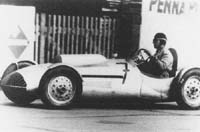 |
Why?
Besides the already described marques a great variety of home-built specials crowded the fields of German Formula 2 and sports car races. At some time it seemed that nearly everybody who was lucky to get his hands on a BMW 328, tried to convert this into some sort of race car with more or less success.
In this chapter I will introduce all of those cars that I have knowledge (and pictures) of. Sometimes my information is rather sketchy and doubtful, nevertheless, with publishing it, I hope to find some readers who can deliver further information on these (and other) cars.
Krakau's special certainly was among the most competitive of those machines, so this early picture of him is perhaps quite a good opener for this section. But before his story and that of all the other special-building enthusiasts is told here it is perhaps a good start to take a look back at the history of the ancestor of all of those cars, the BMW 328.
BMW 328
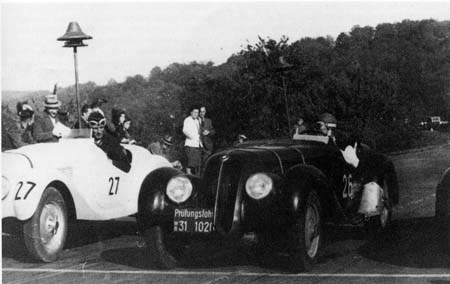
Herrmann Holbein and Rudolf Sauerwein in their BMW 328s at the start of the very first post-war closed-circuit race in Germany, Karlsruhe 1947. The license plate on Holbein's car indicates him being on a "test drive" as racing was still forbidden officially…
The BMW 328 was the competition model and also the final point of the development of BMW's pre-war six-cylinder series. This had its traces back well into the early thirties, starting with the 303 model in 1933. The 328, a roadster variant of the comfortable 326 limousine, caused quite a sensation at its first outing, not only because of its brilliant styling and finish, but also because BMW works driver Ernst Henne drove it to its maiden victory right at its debut, winning the 2-litre sports car category at the Eifelrennen in 1936 in an overwhelmingly superior manner.
So right from its start it was the most successful and certainly also the most popular sports car of its time, totally dominating its class until racing had to be stopped in 1940. So when the BMW 328 became publicly available in 1937 there was a big run on the 464 cars that were built altogether.
What made the car so superior was not its chassis layout in the first place, which was indeed rather conventional: tube section frame with transversal leaf-sprung front axle and rigid rear axle. Because of its aluminium bodywork the BMW was a comparatively light car of only 800 kg. The real sensation was the new engine, the first with light-alloy cylinder heads that came into series production, delivering a power output of 80hp, quite an amount at that time.
Therefore, when racing started all over again after the war it was not surprising that many of its owners began thinking about fitting this powerful engine into a more competitive chassis. But for starters the standard BMW 328 was of course still the mainstay of the early years, showed here on the picture at the start of the very first circuit race after the war at Karlsruhe in 1947.
So before our attention is turned towards the variety of specials based on the BMW 328 here is a brief collection of pictures of the long and successful post-war career of the original model.
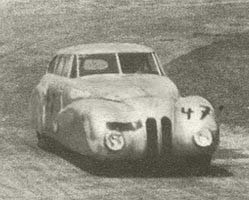
Karl Kling in Loof's specially-bodied Mille Miglia Limousine, in which he won the season-opener at Hockenheim in 1947.
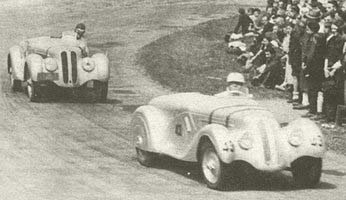
Toni Ulmen and Karl-Heinz Schäufele in the same race (3rd and 4th at the end), Hockenheim 1947.
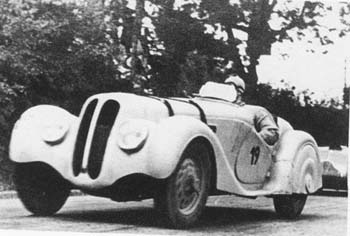
Kling driving his own car to victory, closely followed by Holbein in the HH47 at Munich in 1947.
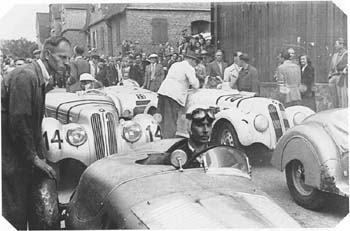
Alexander von Falkenhausen in his 1947 AFM Intertype in front of a whole bunch of BMW 328 forming for the grid at Schotten in 1947. Car No.11 in the background is Roland Mall's streamlined special (see below).

A sketchy picture of Gommann's standard BMW 328, looking very unusual, without wings and lights, but still in original configuration at the start of the Formula 2 race at Cologne in 1949 (part of the original picture is shown below in the Niedermayr/Reif story).
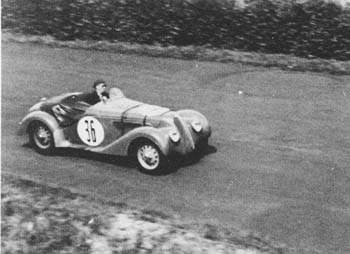
Newcomer Karl-Günther Bechem driving his original BMW 328 into a sensational second place in the sports car race of the 1950 German Grand Prix at the Nürburgring.
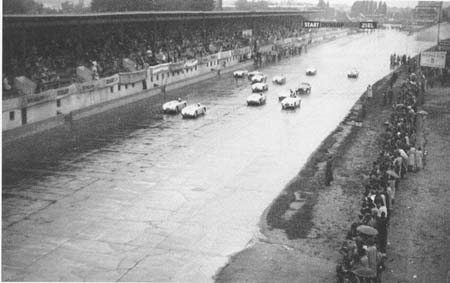
As late as in 1952 one could still spot out Alexander von Falkenhausen's old faithful BMW on the Avus track (car on the right at the back of the field), taking part in the race of the 2-litre sports car class.
Common platform: The BMW 328 as a base for various West German Eigenbau specials
von Müller
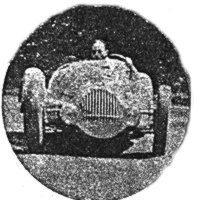
Wilhelm von Müller in his Eigenbau-BMW at the Ruhestein hillclimb in 1946.
I admit that this is one of the worst pictures in my archive, but nevertheless it is a historical one, as it is somewhat representative for German post-war motor racing itself. It shows the ancestor of a vast number of BMW-based Eigenbaus, Wilhelm von Müller's Intertype sports car at the very first motorsport event after the war, the Ruhestein hillclimb in 1946. Besides that little more is known to me and I have no evidence that the car ever reappeared anywhere else again.
Krakau
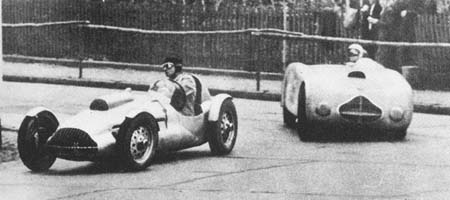
Willi Krakau and his BMW derivate in an exciting battle for the lead with Karl Kling in the Veritas RS at Schotten in 1948.
1948
Willi Krakau was certainly one of the most remarkable of German special builders and able to remain part of the game for a while. But not only that, he was also a really multi-talented sportsman. Before he decided to go racing he had already tried out skiing, sailing, swimming, skin diving and athletics and even got as far as being member of the 1936 German Olympic rowing team.
His first appearance on the racing scene had been in what was probably a standard BMW 328, taking part in the 2-litre sports car race at this very track the year before the picture was taken. There he immediately scored a second place when the race had to be stopped prematurely because of an invasion of the track by the spectators.
In 1948 he appeared at Schotten again with a very handsome and craftily finished special, which can be seen on the picture. In the race he turned out to be the first real challenger of Kling's dominance in that season, who was clearly handicapped by the many "blind" view angles of his Aerosaurian on such a twisty circuit. So right from the start the lead changed frequently between these two drivers until Krakau's engine quit duty on the third lap.
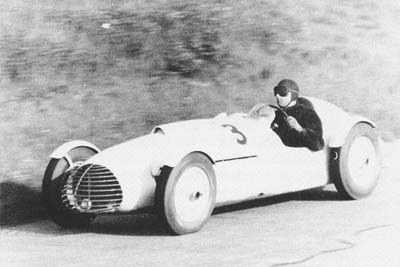
Willi Krakau in his new (or rebodied?) car at the "Grand Prix of the Nürburgring" in 1949.
1949, Pt. I
Krakau had been busy during the winter of 1948-'49 to improve the design of his car, which now was clothed in much more handsome bodywork. Looking at the picture it also seems as if the driver was positioned much lower in the cockpit now.
With this car Krakau impressed at the first of two events at the Nürburgring that year, taking the lead right from the start of the race and setting fastest lap time before he had to retire with engine failure.
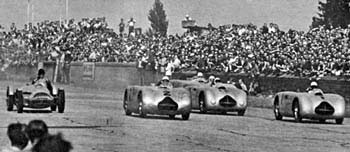
The start of the sports car category during the Grand Prix of the Nürburgring of 1949. The Veritas harmony is disturbed by Krakau's special on the left of the picture. Alongside him is Toni Ulmen (2), while Kling (1) starts from the outside of the front row.
1949, Pt. II
At the second race at the 'Ring Krakau's engine did last and the spectators were able to watch a very exciting race, with Roese, Kling and Ulmen (all on Veritas) and Krakau in his Intertype all having their moments in the lead. On the last lap it was down between him and Kling again, the latter finishing just six seconds ahead at the end.
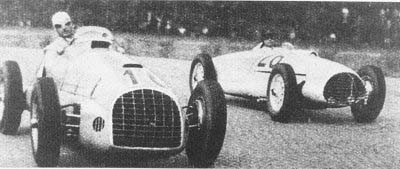
Not many drivers can claim the honour of appearing on a picture in action together with a champion of the format of Juan Manuel Fangio. This is a practice shot from the 1950 Monza Grand Prix, showing Krakau giving way to the Argentinian in his powerful Ferrari 166 V12.
1950
As the Intertype with its detachable wings was also suitable for Formula 2 racing Krakau took the chance of being the first "true" German driver starting in an international event (as Stuck was still using his Austrian license) when he took his Eigenbau to the 1950 Monza Grand Prix.
After his arrival at the Italian track there was initially some dispute with the race officials, who were concerned about the silver colour of his car. Only after he agreed to painting his car white he was finally admitted to the race, as silver was still Germany's "official" race colour! It is obvious that bureaucracy in motor racing has a long history…
But Krakau's difficulties did not end here. There was also a problem of getting tyres and it took a lot of persuasion before he was given a supply by the Pirelli company.
But finally he had it all sorted out and took his place on the grid for the first heat. While Villoresi shot into the lead right from the start followed by his Ferrari team-mates, Krakau was lucky to avoid Palmieri, who had a big shunt in his Maserati. Of course there was no chance to catch up with the three leading Ferraris, but in the end he finished a respectable fourth in front of all the Simca-Gordinis, OSCAs, Cisitalias and Maseratis which had started in his heat.
In the final he had worked himself up into sixth position until his engine had the inevitable bearing failure six laps from the finish.
In 1951 it went a little quiet, but Krakau reappeared in 1952, forming a Renngemeinschaft ("racing association") with Fritz Rieß. That year Rieß preferred a Veritas RS to his AFM, so Krakau could use this car for the German Grand Prix. But neither he nor Harry Merkel, who was given Krakau's Eigenbau, were able to qualify for that race.
At the end of 1952 Krakau sold his special to Hans Klenk, who had formed a race team of his own and entered the car for Ernst Lautenschlager (sometimes also for Hans Herrmann?). But it seems that the car was put aside before the end of the season.
Mall (Spitzmüller)
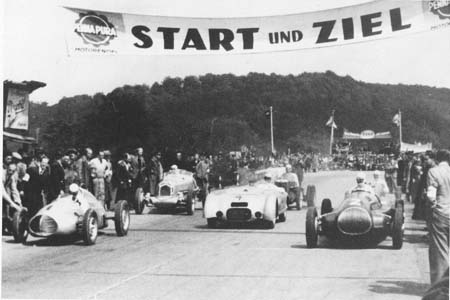
Roland Mall (4) and his unwieldy Eigenbau-BMW in the middle of the grid for the race at Karlsruhe in 1948. The other starters (from left to right and from front to back) are: Polensky / Monopol (1), Brütsch / Westenrieder-Maserati (2), Hellmuth Deutz / Alfa Romeo "Monza", Holbein / HH48 (behind Brütsch) and an unknown car with the double rear wheels at the back of the grid, possibly Kurt Kiefer's Maserati 26M.
1948, Pt. I
Roland Mall appears in my records with a first result in the 2-litre sports car class of the 1947 race at the Schottenring, where he finished fourth in a BMW. The source is not very clear whether this car was still a standard 328 model, but it is certain that he appeared with a BMW-engined Eigenbau for the next season, this time campaigning in the race car class.
The concept of this car was obviously very similar to the contemporary Veritas RS, a BMW engine beneath all-enclosing pontoon bodywork, but in overall appearance it lacked much of the elegance of Loof's design.
In the first race at the fast Hockenheimring Mall had already impressed with a fine second place, which he repeated in the next race at Karlsruhe, when the new monoposti of Polensky and Holbein failed.
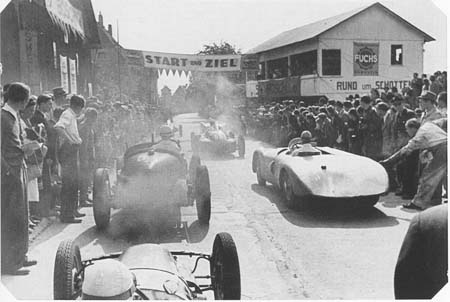
The start at the Schottenring race in 1948. While Polensky's Monopol and Meier's Veritas in the front row of the grid can hardly be spotted through the dust, the ugliness of Mall's Eigenbau (3rd row on the right), which seems to be even greater from this rear view, is clearly visible. Alongside him is Hellmuth Deutz in his Monza Alfa Romeo, while the car on the second row is Brütsch's Westenrieder-Maserati. In the foreground the nose of Lehder's LTE, taking part in the simultaneous race of the Kleinstrennwagen (smallest cars) class.
1948, Pt. II
This picture, taken at the start of the Schottenring race, shows clearly the not very handsome appearance and the rather low level of workmanship of Mall's Eigenbau, indicated by details like the poor finish of the bodywork and the rather provisional looking seat of the driver.
Regarding this, Mall's results seem rather impressive but of course the opposition was not too strong at that time, at least not in numbers, and interestingly the car turned out to be much more reliable than the machinery of the other contenders. For example here at the Schottenring he achieved a place on the podium again, but he was only third out of three finishers…
So it lasted until the deciding race of the season, the Eggberg hillclimb, before he lost his last title chances, ending up second in the championship. But as a consolation he finally won the last race of the season at the ultra-high speed Grenzlandring circuit, where certainly the streamlined bodywork of his car gave him a big advantage over his opponents.
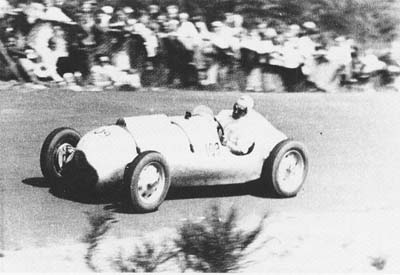
Roland Mall in what was called the "Spitzmüller-BMW" at the Nürburgring in 1949.
1949
In 1949 Mall appeared at the Hockenheim race with an open-wheeled car with Intertype bodywork. It was entered as Spitzmüller-BMW, named most probably after its designer, and I have no idea whether this was a new car or the former Eigenbau, now rebodied.
The debut of the car was somewhat disappointing as Mall finished only fourth, seven minutes behind the winner after a race distance of only 80km.
During the 1949 season Mall swapped between the Formula 2 and the 2-litre sports car classes on some occasions, but could not achieve much success in either of them. His last appearance was at the Grand Prix of the Nürburgring, where the picture was taken. Again he arrived fourth out of four finishers and it seems that he did not appear again thereafter.
Niedermayr (Reif, BMW-Meteor)

The grid of the race at Cologne in 1949. No.114, on pole position, is Kling, giving the new Veritas Meteor its debut. No.115 is Helmut Niedermayr in the Reif-BMW. 2nd row: Ulmen / Veritas RS (108); 3rd row: Stuck / AFM 49 (106), alongside him Rieß / Holbein HH 48; 4th row: Willi Briem / Holbein HH 47 (105); 5th row: Polensky / Monopol (100), alongside him (hidden by Rieß) Heinz-Gerd Jäger / Veritas RS; 6th row: Gommann / stripped standard BMW 328; back of the grid: Brütsch / Westenrieder-Maserati.
1949-'50
This picture of the grid at the Cologne race shows almost the whole variety of German Formula 2 racing during the 1949 season. Interesting in the context of this passage is the car at the right front of the picture, Helmut Niedermayr's Reif-BMW.
The story of this driver and his cars is still a little bit mysterious to me. What I know of him is that he was resident at Berlin, rather of the western than of the eastern part, at least in the later years. At that time the Berlin wall had of course not yet been built and the city still had very much an exceptional status (remember the Berlin crisis of 1948!). Travelling between east and west was still possible, at least for Berlin citizens, and Niedermayr seemed to make full use of this, as he appeared frequently at races in both parts of the divided country.
My opinion about his Western Berlin passport is based on two circumstances: firstly he founded a racing team (Renngemeinschaft Halensee), which was clearly western-based and used Veritas and AFM cars, which were usually not available for the East Germans. And secondly his entry was accepted by the organizers at the Sachsenring race in 1952, while a driver like Fitzau, who had defected from East Germany, obviously was not welcome there any more (or perhaps would not have dared to travel there).
But on the other hand Niedermayr was a common guest in East German events, at least in the early years, choosing the Sachsenring for his debut at the end of the 1949 season, where he started in the 2-litre sports car category, and certainly he did not feel very comfortable with the division into West and East German citizens at that time. So of course his frequent visits must have been very appreciated by the GDR officials, as the East German administration, fully liable to Stalin's policy, did not leave out any occasion to propagate reunion of the country.
The car in which he started in those events was a BMW-engined special called the Reif. This of course might trace to East German engineer Reif, who ran a BMW (later EMW) garage at Chemnitz and might also lead to the conclusion that there could be some connection to Rudi Krause's car (see the later East German specials section), but I did not find any confirmation for this in my sources. According to Krause's story it is also well possible that generally Reif was only responsible for engine tuning, while the chassis had to be delivered by the driver himself, but this is also only an assumption as well.
Only a week later after Niedermayr's appearance at the Sachsenring this picture was taken, showing him with his Reif special on the front row of a comparatively large grid at the Cologne race. With most of the other German star drivers present this indicates that his practice performance certainly must have been quite impressive.
Looking at the picture it is easy to recognize that his car was built in "intertype" style, which allowed it to be entered in sports car races (with motorcycle-like wings and lights attached) as well as in Formula 2 events. Of course the disadvantage was that this resulted into a very wide bodywork, as there had to be room for a "passenger" to comply with the contemporary sports car rules. This resulted in much more drag compared to the much more slender monoposti. On the other hand this effect was perhaps at least partially compensated, as the offset cockpit position allowed the driveshaft to be positioned alongside it and the driver could be placed lower in the car.
In the race itself Niedermayr seems not to have been among the finishers, as he does not appear on the result list but, alas, I do not have any further information.
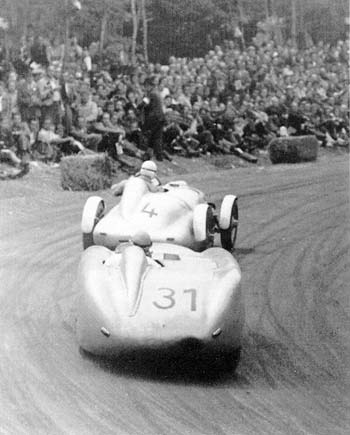
Paul Pietsch in the 1500cc Veritas RS chasing Niedermayr's Reif Special at Solitude in 1950.
1950
Car and driver turned up again in the records when Niedermayr scored a series of second places in the sports car class at the Schauinsland hillclimb, the Solitude race and the Sachsenring.
This picture shows Niedermayr being pursued by the leader of the smaller class, Paul Pietsch in the 1500cc Veritas, who had already closed up in spite of having started some four minutes behind the big cars.
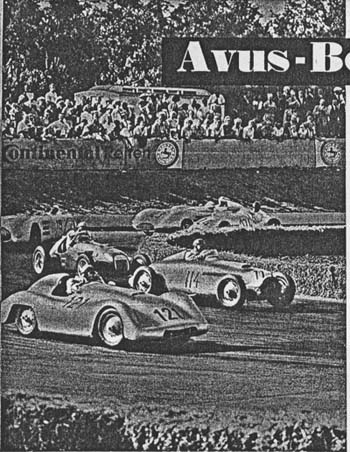
Niedermayr / "BMW-Meteor" (114), Fritz Rieß / AFM 50 streamliner (121), Lance Macklin (Stirling Moss?) / HWM-Alta, Theo Helfrich / Veritas RS (119), Theo Fitzau / DAMW (124) and Arthur Rosenhammer / DAMW streamliner (123) in close battle at the Südkehre during the 1951 Avus race.
1951, Pt. I
In 1951 Niedermayr appeared on the entry lists in a car of the confusing make "BMW-Meteor". On the available pictures like this one from the Avus race it is obvious that this was an Intertype as well. It certainly looks different to the Reif-BMW in the picture from Cologne in 1949, especially at the front, but it is not clear whether this was a development of his previous car or a completely new product. The name of the car is a source for several questions, too: Was it a BMW special fitted with a Meteor engine? Or vice versa, a Meteor chassis with a BMW engine installed? Or simply the result of a name change which had become necessary for political correctness, as with cold war reaching the race tracks now public opinion in West Germany certainly did not appreciate one of "their" drivers appearing in East German cars any longer? Perhaps we will never know…
Instead, what we know for sure is that Niedermayr arrived in eleventh place, five laps down to the winner, after having already finished fourth in two sports car races that season, at Hockenheim and the Nürburgring.
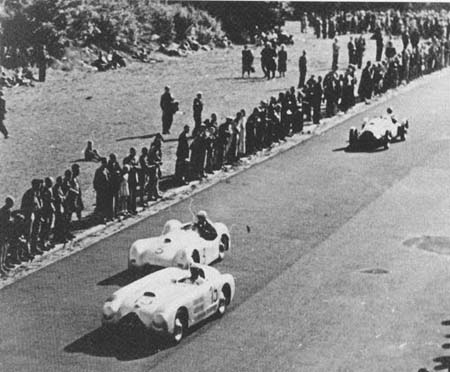
Scene from the Norisring race at Nuremberg in 1951: Josef Peters / Veritas RS (15), followed by Karl-Günther Bechem / Bechem-AFM 50 Sport (3) and Helmut Niedermayr / BMW-Meteor (4).
1951, Pt. II
Another sketchy shot of Niedermayr's BMW-Meteor, this time in sports car shape. But I am afraid it will not help much further in uncovering the identity and the further fate of this car. For more information about the Reif entries take a look at the forthcoming East German specials section.
In 1952 Niedermayr switched to a new Veritas RS for the sports car races, perhaps the first such car that Loof had produced in his new premises at the Nürburgring. In Formula 2 his entries were made under the banner of the Renngemeinschaft Halensee, which fielded a Veritas Meteor as well as an AFM 50 for him and on one occasion also for Franz Bumke.
With his Meteor he had the dreadful accident at the Grenzlandring, luckily sustaining "only" mediocre injuries, after which he seems to have ended his career.
Schöpflin
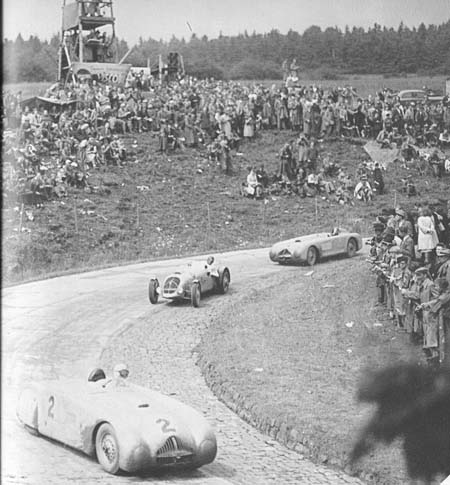
Ulmen / Veritas RS (2), followed by Otto Schöpflin (8) in his Eigenbau-BMW and another Veritas RS at the downhill serpentine corner, Schottenring 1949.
Otto Schöpflin was another pioneer of German post-war sports car racing, initially in 1948 in a standard BMW 328 with an engine tuned by himself, in which he finished second at Karlsruhe and third at Hockenheim, Cologne and the Grenzlandring.
It seems that for 1949 he had converted this car into the Intertype special which can be seen on the picture above. After his starts at Munich and at the Schottenring his trace gets lost.
Assenheimer (WAM-BMW)
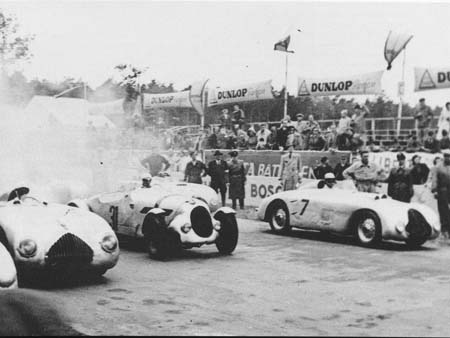
Could the car on the right be Walter Assenheimer's BMW Eigenbau? At second glance one can certainly spot out enough differences not to regard this as a standard Veritas RS. With the starting number clearly visible it should not be too hard to identify the car if somebody has the original race programme available. The car in the middle of the picture is the 1500cc Lancia Special of von Strachwitz, shooting into the group of 2-litre cars at the start of the sports car race at Hockenheim in 1951.
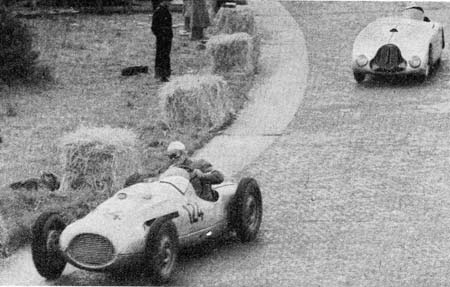
The car from another angle, chasing Rudi Krause's Reif-BMW. Unknown date (probably 1951?), unknown event!
Walter Assenheimer was a long-term contender of German post-war sports car racing between 1949 and 1951 with his BMW-engined Eigenbau. As it was mistakenly regarded as a standard Veritas RS on some occasions the suspicion that it was quite a look-alike is perhaps not too far-fetched. So is it the obscure car which can be seen on the pictures?
Other BMW-engined specials from West Germany
Of course there were a lot more of those home-built specials based on the BMW 328 in West Germany. The following list contains all cars which are mentioned somewhere in my records, but without a picture available:
- Gerbel, 1948, Fritz Gerbel
- Prinzbach, 1949
- Weißenberger, 1950, Theo Weißenberger
- Adolff (?), 1951, Kurt Adolff
- Sandgathe, 1953, Clemens Sandgathe
The outsider: von Strachwitz (MSM-Lancia)
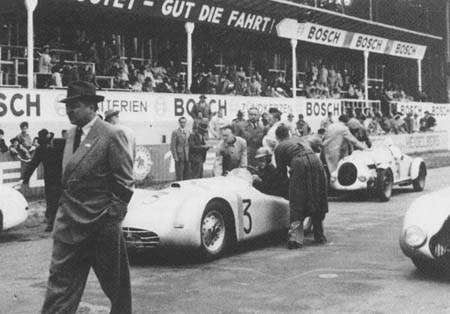
The grid of the combined 2000cc/1500cc sports car race at Hockenheim in 1951. The car in the back with No.31 is Mauritz von Strachwitz' Lancia Eigenbau, taking its position behind the converted AFM 50 of Karl-Günther Bechem (3).
1951
What would German post-war Formula 2 racing have been without the BMW 328, with even the Veritas Meteor being at least inspired by this legendary sports car? But while all of his fellow countrymen used the approved BMW as a platform for their home-built specials Mauritz Freiherr von Strachwitz preferred to rely on Lancia parts for his designs.
He started sports car racing in the 1951 season with this home-built Intertype special, based on a Lancia Aprilia. With its 1.5-litre engine he regularly started in the smaller sports car class, which often was combined with the 2-litre machines.
The reason why the car is introduced here is simply that there was no 1.5-litre class at the Norisring race that season, so that von Strachwitz had to enter the race of the bigger cars.
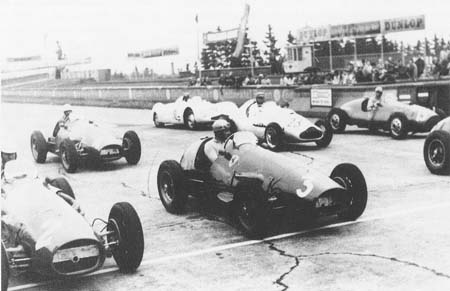
On the grid for an unofficial practice session before the 1953 German Grand Prix: The front row is occupied by the Ferraris of Ascari (3) and Farina (2), behind them Villoresi in the third car of the Scuderia (4). Nos. 23 (second row) and 30 (at the back) are the Veritas Meteors of Heeks and Loof, while No.13 is the proof that the MSM-Lancia of von Strachwitz had also been there!
1953
Despite the fact it was already announced that Formula 2 would not continue after the 1953 season, von Strachwitz announced yet another new car to be ready in time for the German Grand Prix.
Built around a tuned Lancia Aurelia V6 engine of 160hp the car was based on a double tube-section frame of only 47kg combined with standard Lancia suspension. Together with the handsome bodywork, made by the Rupflin company, the overall weight of the car was at about 580 kg.
But when von Strachwitz appeared at the Nürburgring he had trouble being admitted to the race. Shortly before he had been involved in a traffic accident, and his driving licence had been confiscated. The officials insisted that without this he would also loose his racing license and refused his entry just as they already had done at the Avus race before.
Only under reservation he was admitted to an unofficial pre-practice session until these legal problems would have been sorted out. Of course German officials always took their jobs seriously and consequently von Strachwitz found himself in a spectator's role when official practice began! Later that year he finally got his licence back in court, but of course this was too late.
Foreign guests
Wagner
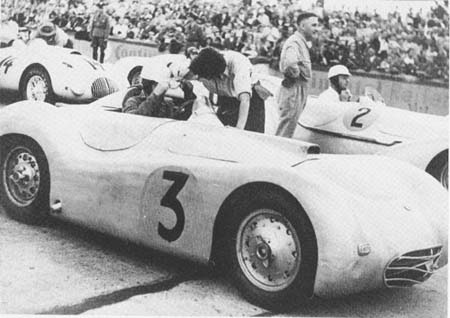
The 2-litre sports car race during the weekend of the 1952 German Grand Prix: Behind Bechem's AFM Special (3) and Ulmen's Veritas "Großmutter" (2) the front part of Honore Wagner's Eigenbau-BMW (14) sneaks into the picture.
Hopefully Luxembourg will forgive me for including Honore Wagner in this story about German specials. But at least nowadays the Formula 1 race at the Nürburgring is run under the offical title of Grand Prix of Luxembourg and certainly Wagner's handsome BMW special was such a familiar view in Germany that the rare pictures of the car are worth to be shown here, even if he had to retire from this race, which was part of the 1952 Grand Prix weekend at the Nürburgring.
Lundberg (BLG)
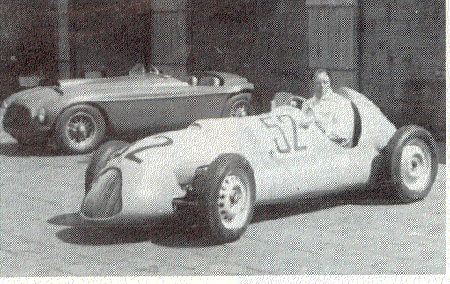
The BLG 2000 special of Bertil Lundberg at the 1950 German Grand Prix.
The picture shows another foreign BMW special, the BLG 2000 of Swedish driver Bertil Lundberg, who took part in the 1950 German Grand Prix at the Nürburgring. It seems that the car lasted only for a single lap.
Balsa

While Felice Bonetto spins his Maserati on the opening lap of the 1952 German Grand Prix, Marcel Balsa in his BMW special (110, in the foreground) and Hans Klenk in the Veritas Meteor (128) manage to avoid collision.
Marcel Balsa was another one-time guest in Germany, taking part in the 1952 German Grand Prix with his special, when he retired after the 5th lap with a broken rear axle. The car is reported to have been based on a Gordini chassis with a BMW engine installed. Quite strange!
Picture sources
- Reinald Schumann: Motorsport in Deutschland 1945-1955
- Copies of old race reports, like issues of Das Auto, but some of them also unknown to me
- Ingo Seiff: Der Schottenring
- Website of Joachim Traber
- Official Website of the new Veritas company
- Riedner: Doppelsieg (Pietsch Biography)
- Eberhard Reuß: Grand Prix
- Walter Zeichner: Kleinwagen International
- Werner Oswald: Deutsche Autos seit 1945
- Website of the Auto-Salon Singen auction
- Website of Prova, Magazin für Automobile Avantgarde
- Website of the Society for Revival of the Solitudering race track
- Arthur Rosenhammer, Günther Graßmann: Motorsport Almanach 1953
- Rudi Krause: Zwischen Box und Fahrerlager
- Roger Gloor: Nachkriegswagen
- Werner Oswald: Kraftfahrzeuge der DDR
- Michael Dünnebier, Eberhard Kittler: Personenkraftwagen sozialistischer Länder
- www.bmw-modelle.de
- www.oldtimer-freunde-messkirch.de
- Herbert Beyer: Paul Greifzu – Ein Leben für den Motorsport
- Doug Nye: History of the Grand Prix car 1945-65
- Various issues of Illustrierter Motorsport, official race magazine of the GDR, 1951-1954
Feedback
The author appreciates receiving feedback and/or any information to improve his article. You can reach him at uechtel@gmx.de.
